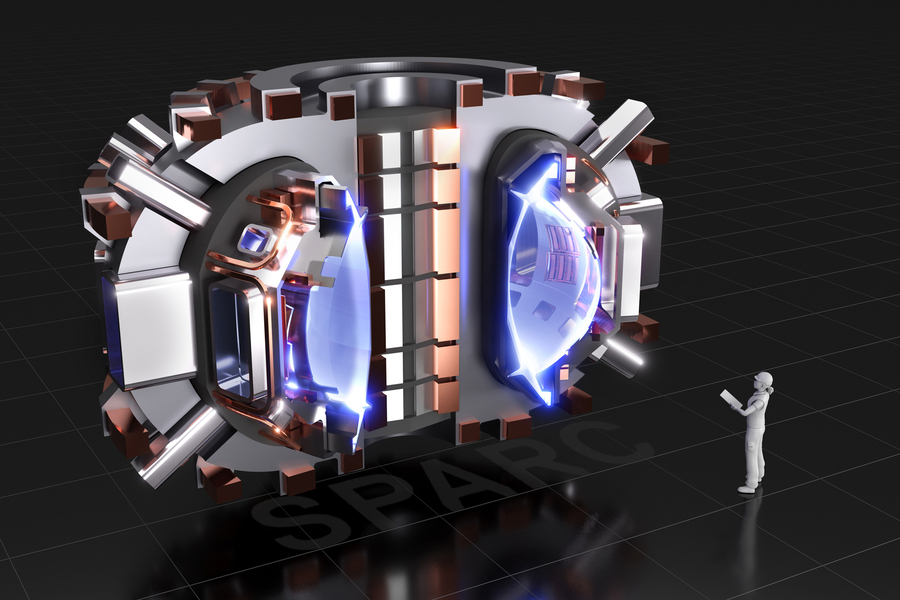"This image shows a cutaway rendering of SPARC, a compact, high-field, DT burning tokamak, currently under design by a team from the Massachusetts Institute of Technology and Commonwealth Fusion Systems. Its mission is to create and confine a plasma that produces net fusion energy." (Credits:Image: CFS/MIT-PSFC — CAD Rendering by T. Henderson) (MIT, Validating the physics behind the new MIT-designed fusion experiment)
There are many reports of breakthroughs in fusion systems and fusion technology. And many people wait for new energy to form like the moon from the sky. The fusion energy would solve entire energy problems on Earth. But the problem is how to make a commercial fusion reactor.
The temperature in those reactors is very high. If that plasma, that orbits the reactor in the wheel, or donut-shaped system touches the wall that thing would destroy the reactor immediately. In stars fusion happens in extremely high pressure and on Earth, the system must compensate for that pressure by increasing temperature. That means the fusion system must create a temperature. That is higher than the Sun's core.
When fusion starts, light elements will melt together. Hydrogen's heavy isotopes, deuterium and tritium form helium when they melt together. The problem is that the system presses plasma using a magnetic field. Deuterium and tritium ions are both positive. And that means electromagnetic forces repel those particles away from each other.
Some systems may make (as an example) deuterium ions, and tritium anions, that are negative tritium ions. That makes those ions pull each other together. And that makes it easier to impact those particles. However, the problem is that ions or monopolar ions are easier to control. Using magnetic fields.
So the anion injection must made at the right point. The problem is how to deny anion injection touch with the wall of the torus. In tokamak reactors, positive magnetic fields push positive particles together and keep them off the wall.
Tokamak reactor diagram.
One solution could be double tokamak where those toruses cross each other. In those cases, the system drives anions and ions into toruses, and then those particles impact in cross-points.
In tokamak reactors, the anions are hard to control because the fusion system presses ion flow using the magnetic repel effect. So the system must use a linear structure. Linear fusion reactors are particle accelerators where the system drives plus and minus particles together.
The problem is in ignition. When a laser beam ignites fusion. That thing causes an energy impulse. That destroys the particle flow. Electromagnetic repelling pushes those particles away from each other. And the outside magnetic field presses that plasma into its entirety. The problem is standing waves in the plasma ring. When fusion ignites it sends an energy pulse to that plasma wave. And that energy destroys the plasma structure and stops fusion.
So how stars like the sun can create and maintain fusion? What keeps them together? The sun is a massive object. One thing that keeps plasma in its entirety in sun-scale objects is gravity. But the main thing that holds the sun together is the high energy fusion. That fusion turns 400 million tons of material into energy. That thing forms an interaction where the sun's core is forming low pressure. And gravity pulls particles in the sun's nucleus.
Another thing that keeps fusion going is the electromagnetic repel. There is lots of plasma in the sun. And the electromagnetic interaction or repel effect happens around particles. The electromagnetic repel force from inside presses the particles together, and the thing that keeps fusion going on in the sun are gravity and electromagnetic forces together.
So the electromagnetic repel pushes particles to the inside. It also affects particles. on the sun's shell. The magnetic fields and gravity keep holding the sun together. The problem with tokamak reactors is that they cannot benefit gravity.
https://bigthink.com/the-future/nuclear-fusion-power-update/
https://news.mit.edu/2020/physics-fusion-studies-0929
https://en.wikipedia.org/wiki/Fusion_power
https://en.wikipedia.org/wiki/Tokamak
https://learningmachines9.wordpress.com/2024/02/06/fusion-energy-are-we-any-closer-than-before/





No comments:
Post a Comment
Note: Only a member of this blog may post a comment.